Dynamic Automation Helps Company Create “Snowflakes”
House of Design, located in Nampa, Idaho, provides a unique solution to building trusses, walls, and other building assemblies: they call it dynamic automation. Shane Dittrich, CEO, explained the term as “the robots have no idea what they’re building today.”
Instead of tasking a robot to build only one type and size of assembly, their software analyzes the most efficient order to produce a variety of similar products in, no matter what size they are. The software takes advantage of efficiencies to shave off milliseconds and full seconds from standard automated fabrication.
House of Design’s proprietary software translates 3D models into machine code, which then communicates with the robot to tell it what size assembly to build. Because buildings are designed uniquely and no truss looks the same, the dimensions and how they are assembled look different. Each is a unique size and shape, or a “snowflake,” as Dittrich calls them. “When a robot picks up a stud,” said Dittrich, “it doesn’t care how long it is. The same End of Arm Tool can pick up a stud if it’s a 7-foot wall or a 10-foot wall, it doesn’t matter.”
Their system is able to switch between assembly sizes and shapes quickly and easily, and make each one in succession in the most efficient way. There are some constraints, such as the size of the assembly table, but otherwise the available configurations are endless.
This level of production customization is more complicated than it seems, as customers don’t always request their materials in the same way. Some want trusses stacked from biggest to smallest for shipping, others want them stacked in the order they’ll be installed.
Luckily, their system doesn’t care and simply fulfills the requested order in the most efficient way given the customer’s requests.
Before production begins, the software analyzes and validates the design, helping to ensure that the assembly is in the proper sequence and that there aren’t any problematic areas that need to be addressed. This helps keep the manufacturing process running smoothly. There are design constraints and material tolerances that must be taken into consideration, but otherwise the system can build almost anything.
“In my mind it’s relatively easy to program a robot to build a wall with studs 16 inches on center. It’s just a stud every 16 inches on the top and bottom plate. It’s a little more difficult to program it to do laminations, staggered studs, blocking, lay flats, and double top plates.” Even complex designs, like wall panels with window and door openings, are able to be programmed into the system.
The software is programmed in multiple languages, including ABB’s proprietary robot language called Rapid, and more standard languages like Rust and PLC-structured text.
Although the rest of the world is fascinated with artificial intelligence, Dittrich said its influence on his process is limited. “Right now, to look at a process and take milliseconds out of a robot’s move takes an experienced robot person. These experts can take a process that takes five seconds down to three and a half. When you’re running that process 24/7, that second and a half adds up. I do believe that AI is going to be able to help us with that in the future.”
The company stays with its customers, working with them on system installation, training, and operations. They provide resident engineers with each system to work side by side with operations workers until it is up and running smoothly.
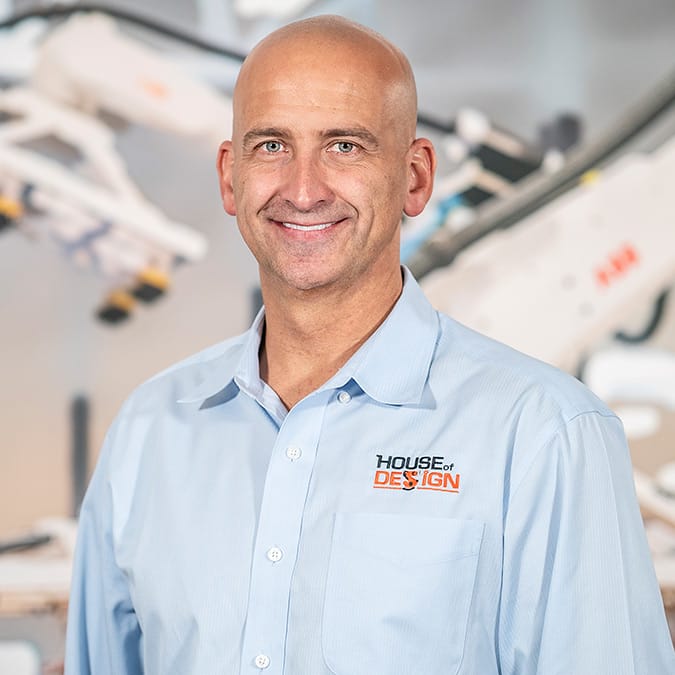
Shane Dittrich, CEO at House of Design.
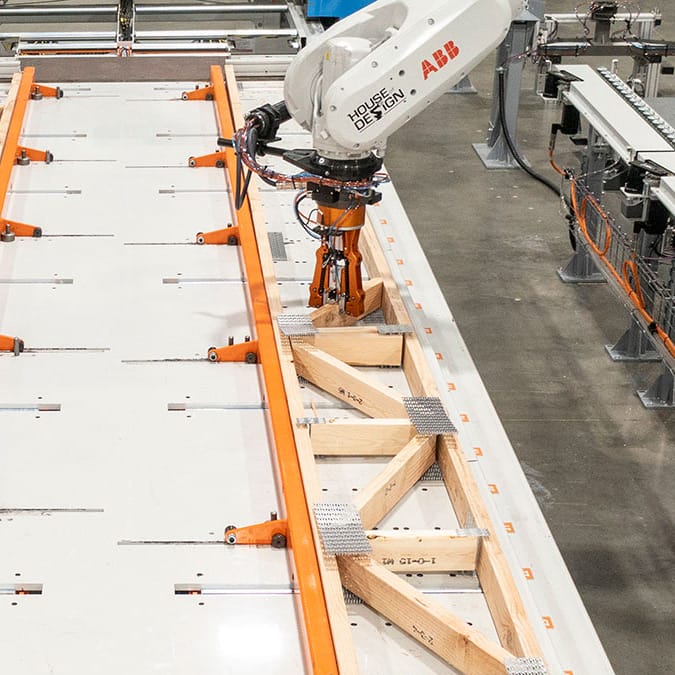
A House of Design-programmed robot assembles a truss for a modular building.
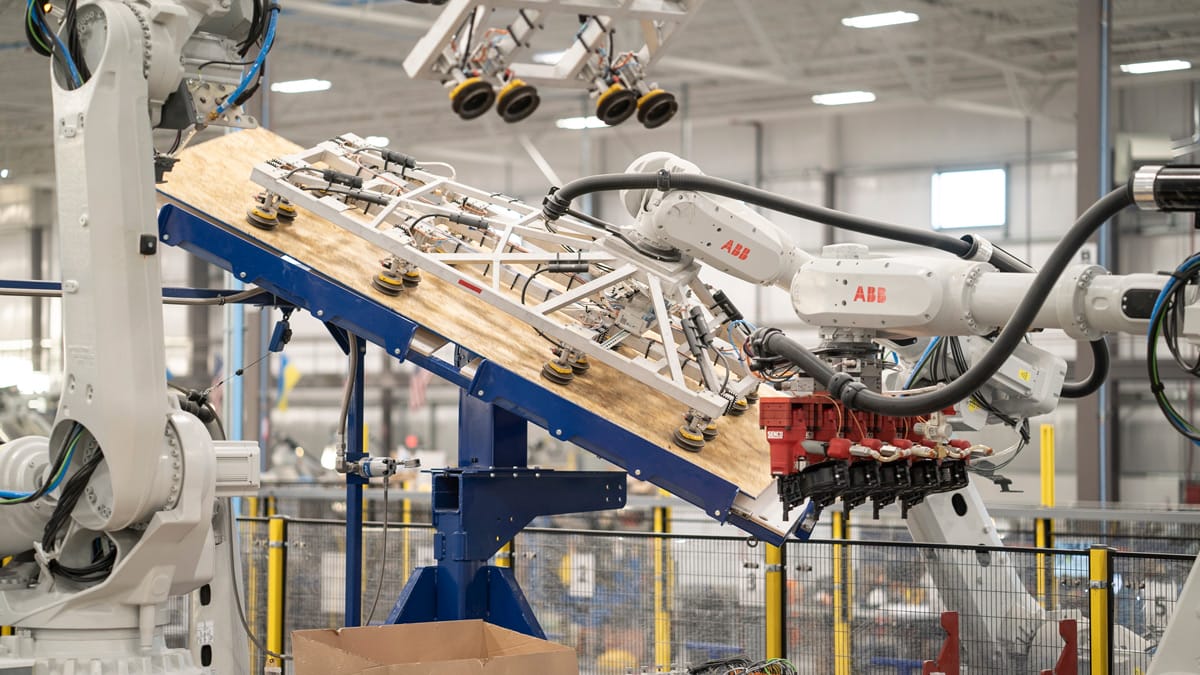
Starting Small
House of Design was founded in 2012 and was focused on custom robotic automation. As Dittrich put it, “We would do anything and everything for anybody.” The company quickly grew from two to almost 100 people right now.
In 2018 they landed work with both Katerra and Autovol. Dittrich has a lot of respect for how Katerra pushed the industry forward, and the contract with Autovol is ongoing and has led to the construction of almost 30 miles of wall assembly.
After getting the contracts with Katerra and Autovol the company pivoted to focus almost exclusively on construction and modular building. Their mission now is to use their robotic automation solutions to help solve the affordable housing crisis.
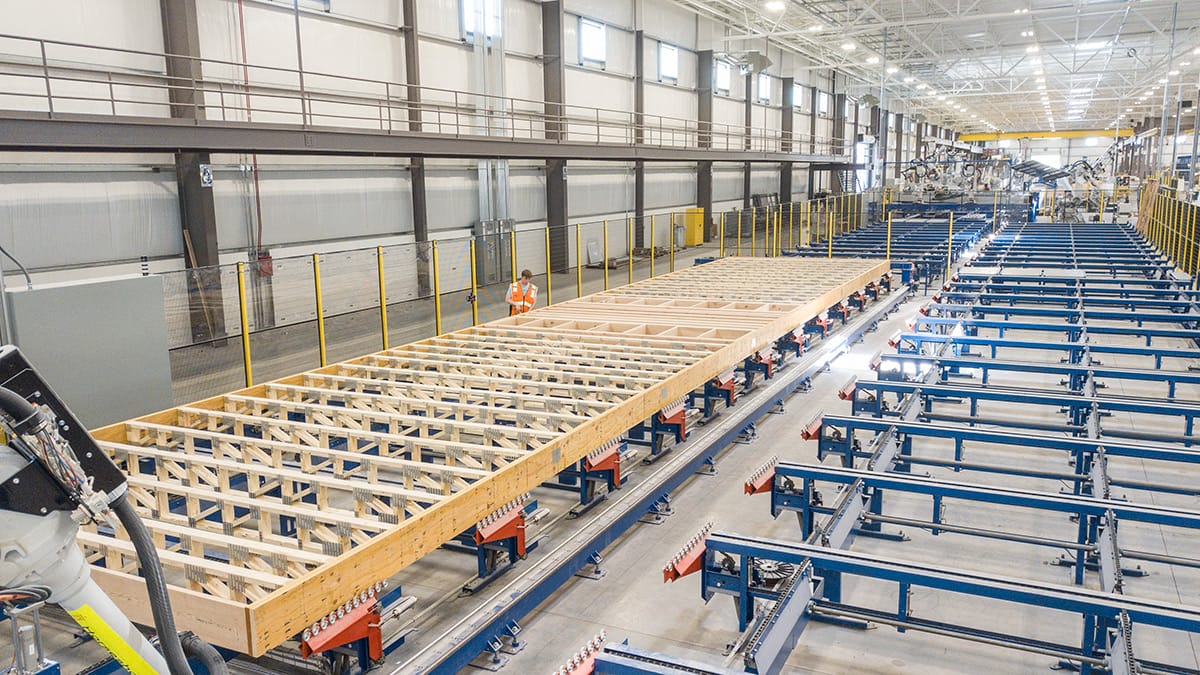
Benefits of Automation
Dittrich sees several benefits to the increased use of robots and automation in the construction industry. One of the most important is that technology opens the door to more diversity in the workforce. It has the ability to appeal to a wider audience, such as women, those of smaller stature, older workers, and those with technological knowledge and aptitudes. “Nowadays younger workers don’t want to be lifting 4 feet by 8 feet sheets of gypsum board all day long. It’s a hard job, and nobody should have to do it. But they love operating a robotic system. It’s almost like gaming to them. Automation opens up the available labor pool for factories.”
Another benefit is improved safety. “We want to get the nail guns out of worker’s hands, because I can guarantee you’re going to have an accident. At Autovol, we’ve built 28 miles of wall assemblies without someone getting hurt with a nail gun. At a manual manufacturing facility, it’s almost guaranteed that someone has driven a nail into their hand.”
Consistent quality is another advantage. “We’re going to pump out the exact same thing every single time.” People can have bad days and bring those bad days to work, greatly affecting the product that comes out of a factory. Automation helps bring consistency to the process.
Labor savings is another benefit that is discussed in the industry, but Dittrich sees it more as labor redistribution. “I don’t know of any company where we’ve gone in, installed automation, and they actually removed or fired people. Usually, they move them to a process that isn’t automated to increase production.”
The Future of Automation
Unfortunately, the cost of automation is increasing, as the price of the steel and electronics used to build robots has gone through the roof in recent years. Dittrich said the industry needs to rethink its mindset when it comes to the role of automation in the workforce. If contractors don’t have enough workers to produce according to project schedules, they’ll need to seek out alternatives, such as automation, to help them keep up with building demand. At that point, cost isn’t going to be as important.
Although automation, even dynamic automation, may not solve all of the construction industry’s woes, it can make significant improvements in specific areas and on specific tasks. “It’s a solution to the specific task that you’re automating, and if it pencils out, then great. If not, that task is not for automation.”
Dittrich sees more on-site manufacturing as the future of automation in the construction industry. Although moving production out of the controlled environment of a warehouse or factory does present risks. Efficiency and safety may be compromised. When asked if we’ll see buildings built exclusively by robots in the near future, Dittrich says he can see that if we address the differences in local building codes and standardize materials dimensions and quality. “You improve those two things, and we will be right there with you to automate those processes.”
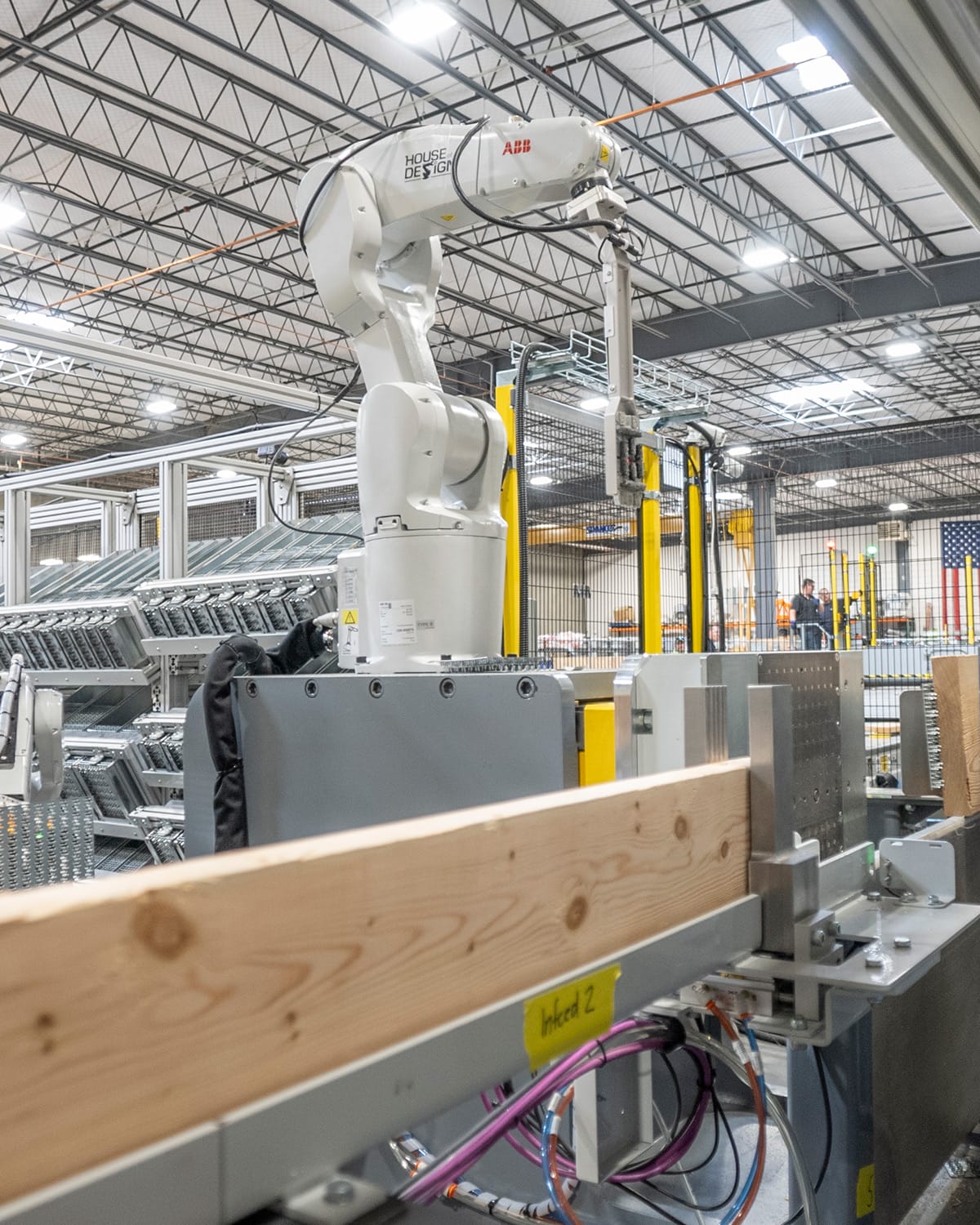
About the Author: Dawn Killough is a freelance construction writer with over 25 years of experience working with construction companies, subcontractors and general contractors. Her published work can be found at dkilloughwriter.com.
More from Modular Advantage
Resia: Breaking All the Rules
Resia Manufacturing, a division of U.S.-based Resia, is now offering prefabricated bathroom and kitchen components to industry partners. Its hybrid fabrication facility produces more precise bathroom and kitchen components (modules) faster and at lower cost than traditional construction. Here’s how Resia Manufacturing does it.
How LINQ Modular Innovates to Bring Modular To The Market in the UAE and Beyond
LINQ Modular, with an office and three manufacturing facilities in Dubai, is a modular firm based in United Arab Emirates. The company is on a mission: to break open the housing and construction markets in the Gulf Cooperation Council (GCC) area with modular.
ModMax: Redefining Modular Construction with Confidence and Precision
ModMax was born out of frustration—frustration with five persistent pain points in modular construction: Permitting bottlenecks. Production delays. Rigid designs. Disconnect between “the office” and the field. Lack of transparency and communication.
LifeArk: Disaster-Resilient Housing from Recycled Plastic and 100-year-old Technology
Wee compares LifeArk’s housing units to Yeti coolers, as they are built similarly. Each component takes 15 to 20 minutes to manufacture, has an R-value of 40, and includes molded slots and chases for wiring, plumbing, fire sprinklers, and other utilities.
Building the Future of Modular Edge Infrastructure
The edge data center market is expanding rapidly, driven by the surge in AI workloads, IoT adoption, and the need for localized compute power. In these environments, sustainability, scalability, and reliability are non-negotiable. Cooling is among the most complex challenges for operators—and one of the most decisive factors in long-term success.
Accelerating Light-Gauge Steel Construction: A Semi-Automated Digital Workflow for Off-Site Projects
For construction professionals, the message is clear. By adopting semi-automation and digitalization, companies can deliver projects faster, more accurately, and more profitably, while also building stronger collaboration across teams. The approach is not about replacing people with machines, but about empowering people with better tools and processes.
Why Modular Data Centers Are Gaining Momentum
Artificial intelligence, high-performance computing, and edge applications push the limits of traditional “stick-built” data centers. They take years build, often struggle with high density workloads, and aren’t optimized for deployments near end users. Modular data center platforms are purpose-built to address these challenges, offering flexibility and scalability to adapt to evolving technologies, while opening new opportunities for the modular construction industry.
Supply Chain Innovation in Action: 5 Habits Every Modular Leader Should Practice
By applying these principles to supply chain practices — collaborative planning, strategic procurement, scenario modeling, digital tools, and transparent forecasting — construction leaders can build value chains that are not just efficient and agile, but truly innovative.
Exploring the Role of Modular Integrated Construction (MiC) in Advancing Circular City Principles – A Survey of Stakeholder Perspectives
The survey findings highlight the significant potential of Modular integrated Construction (MiC) in advancing the development of circular cities. By reducing costs, accelerating construction timelines, and minimizing waste generation, MiC offers a promising approach to sustainable urban development.
The Use of MS POLYMER™-Based Sealants and Adhesives in Modular Building
These products combine flexibility and elastic recovery with excellent adhesion to different substrates and have already shown their usefulness in traditional construction. Now it’s time for them to be put to use in the modular construction industry.










